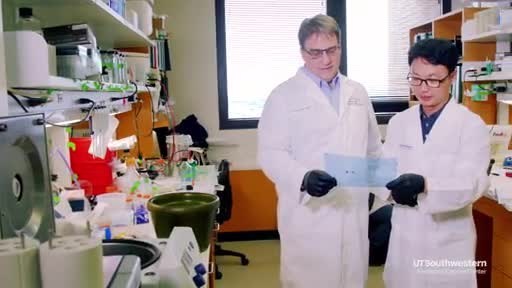UT Southwestern Researchers find evidence a cancer drug may be extended to many more patients
DALLAS, July 24, 2019 /PRNewswire/ -- A new molecular mechanism discovered by UT Southwestern researchers indicates that drugs currently used to treat less than 10 percent of breast cancer patients could have broader effectiveness in treating all cancers where the drugs are used, including ovarian and prostate cancers. The new study also revealed a potential biomarker indicating when these drugs, called PARP inhibitors, can be unleashed in the fight against cancer.
"These findings could increase the patient population benefiting from these drugs by two, three, or four-fold. Up to 70 percent of breast cancer patients could now be good candidates," said Dr. W. Lee Kraus, Director of the Green Center for Reproductive Biology Sciences at UT Southwestern. "We have found that PARP inhibitors can act by a mechanism that is different from those previously identified, which rely on BRCA-dependent DNA repair pathways."
This research helps explain why breast cancer patients can be responsive to PARP inhibitors even if they don't have BRCA gene mutations.
The Kraus team's findings were published in the journal Molecular Cell on July 24.
PARP inhibitors were approved by the FDA in 2014 for the treatment of ovarian cancers containing BRCA mutations, rare genetic mutations that disable a DNA repair pathway in cancer cells. The FDA also approved PARP inhibitor for breast cancer treatment in 2018. In their current use, doctors prescribe PARP inhibitors to disable a second DNA repair pathway, making it difficult for cancer cells to survive.
Dr. Kraus' lab discovered that while this war on DNA repair is being waged, PARP inhibitors are also battling for dominance elsewhere in the cancer cell. It is an important, effective fight previously unknown to science. The PARP inhibitors also attack the machinery that makes proteins, called ribosomes.
"Cancer cells are addicted to ribosomes. Cancer cells grow fast and must make proteins to support cell division and other essential processes going on in the cell. If you can slow down or inhibit the production of ribosomes, then you can slow down the growth of the cancer cell," Dr. Kraus said.
This new understanding changes the way that scientists and clinicians think about PARP inhibitors and their clinical applications, which previously have been focused on DNA repair pathways since the initial discoveries in 2005. It took more than a decade to get PARP inhibitors approved by the FDA. New applications of PARP inhibitors based on Dr. Kraus' discovery could reach patients much quicker because three PARP inhibitor drugs are already approved and in use.
"The historical view is that cancers need the mutated BRCA gene to be sensitive to PARP inhibitors. That's what most scientists and clinicians thought," Dr. Kraus said. "But what the field is now coming to realize is that's just not true."
The realizations Dr. Kraus mentioned come from recent laboratory science, preclinical studies, and clinical trials throughout the nation that show additional signs of PARP inhibitors' effectiveness in the absence of BRCA mutations. But a clear molecular explanation for these effects has been lacking – until now.
The new study maps out this molecular pathway in its entirety and identifies a potential biomarker, a clinical test, that might indicate which patients may benefit from PARP Inhibitors. The biomarker is based on a protein called DDX21, which is required for the production of ribosomes in small subcellular compartments called nucleoli. The presence and function of DDX21 in the nucleolus requires PARP-1, the target of PARP inhibitors. Treatment with PARP inhibitors blocks DDX21 function and causes it to leak out of the nucleolus and disburse throughout the nucleus, thus inhibiting ribosome production. High levels of DDX21 in the nucleolus indicate cancers that might be the most responsive to PARP inhibitors.
The Kraus team found the new pathway and potential biomarker by examining a wide spectrum of breast cancer cells, some of which naturally have low levels of PARP. The low-PARP-level cells behaved like cells in which PARP activity was reduced by PARP inhibitors. The discovery builds on 15 years of PARP research so intense that Dr. Kraus' laboratory team put a molecular model of PARP-1 on his birthday cake.
"We started by trying to identify new molecular mechanisms and pursued this line of inquiry. We didn't know where the study would lead," he said. "We started as pure basic scientists, but as the study progressed the clinical relevance became more evident."
The next step is clinical trials Dr. Kraus is currently developing with UT Southwestern oncologists who treat breast and ovarian cancers.
Dr. Kraus is a founder and consultant for Ribon Therapeutics, Inc., which studies PARP inhibitors, and he holds a patent covering reagents used in this research.
SOURCE UT Southwestern Medical Center

Related Links
WANT YOUR COMPANY'S NEWS FEATURED ON PRNEWSWIRE.COM?
Newsrooms &
Influencers
Digital Media
Outlets
Journalists
Opted In

Share this article